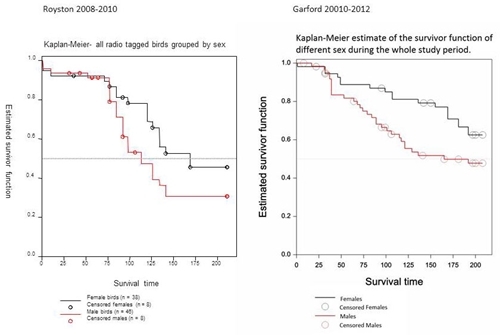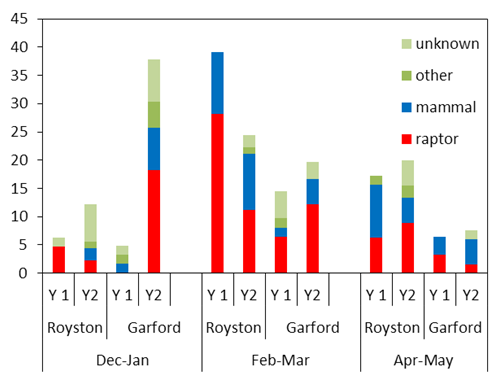Causes of grey partridge overwinter losses on lowland farmland in England
 In winter 2008, we began work to investigate the factors affecting grey partridge losses during winter, a crucial period in the life history of the species but largely ignored by researchers until now. Based on the GWCT’s Partridge Count Scheme data we know that average winter loss across Britain is around 53%, whereas, for example, in Aisne (France) it seems the be only around 27%. We have now completed four seasons at study sites in Royston, Herefordshire and Garford, Oxfordshire and are currently finalising the second and final field season at a third site near Andover, Hampshire, which started in winter 2012/13. We aimed to catch entire coveys during the day and radio-tag six individuals per covey (adult male and female, two juvenile males and two juvenile females). Each radio-tagged bird was tracked once a week from December to May and once every fortnight thereafter. Sample sizes of radio-tagged tagged birds are given in Table 1.
In winter 2008, we began work to investigate the factors affecting grey partridge losses during winter, a crucial period in the life history of the species but largely ignored by researchers until now. Based on the GWCT’s Partridge Count Scheme data we know that average winter loss across Britain is around 53%, whereas, for example, in Aisne (France) it seems the be only around 27%. We have now completed four seasons at study sites in Royston, Herefordshire and Garford, Oxfordshire and are currently finalising the second and final field season at a third site near Andover, Hampshire, which started in winter 2012/13. We aimed to catch entire coveys during the day and radio-tag six individuals per covey (adult male and female, two juvenile males and two juvenile females). Each radio-tagged bird was tracked once a week from December to May and once every fortnight thereafter. Sample sizes of radio-tagged tagged birds are given in Table 1.
Table 1: Sample sizes of radio-tagged birds. Figures in brackets are additional birds re-tagged in the second calendar year and hence studied for two years
| Site |
Year |
Juv male |
Juv female |
Ad male |
Ad female |
Total |
| Royston |
2008/2009 |
24 |
19 |
12 |
9 |
64 |
| Royston |
2009/2010 |
33 |
35 |
12 (2) |
10 (2) |
90 (4) |
| Garford |
2010/2011 |
24 |
25 |
7 |
6 |
62 |
| Garford |
2011/2012 |
28 |
26 |
6 |
6 (1) |
66 (3) |
| Total across 4 years |
109 |
105 |
37 (4) |
31 (3) |
282 (7) |
 Demonstrating how to catch coveys of greys for the BBC One show
Demonstrating how to catch coveys of greys for the BBC One show
Results
Dispersal at both sites commenced shortly after covey break-up in late January/early February. Dispersal distances were shorter at Royston (avg. 17.8 pairs/km²) compared to Garford (avg. 6.7 pairs/km²). At both sites the majority of birds remained within 1km (87% Royston, 81% Garford). Juveniles dispersed more and further than adults and males generally further than females with unpaired juvenile males moving the furthest. The maximum distance for males was 4.7km and 2.7km for females, both juveniles.
Mortality was lowest during the covey period (Dec-Jan), highest during the pairing period (Feb-Mar) and intermediate during the pre-breeding period (Apr-May), but varied considerably between years and sites. However, at both sites, males suffered from higher mortality than females between Jan-May (Fig 1) and overwinter mortality was mainly caused by raptors (predominantly sparrowhawks), followed by mammals (predominantly foxes) and other causes, mainly human inflicted (Fig 2).
Figure 1: Mortality of male and female grey partridges at Royston and Garford from 1st December onwards. Data pooled across both years per site (Kaplan-Meier)

Figure 2: Percentage and cause of death of radio-tagged grey partridge between December and May at Royston and Garford, two years each (Y1, Y2)

Further reading
- Watson, M., Aebischer, N.J., & Cresswell, W. 2007. Vigilance and fitness in grey partridges Perdix perdix: the effects of group size and foraging-vigilance trade-offs on predation mortality. Journal of Animal Ecology, 76: 211-221.
- Watson, M., Aebischer, N.J., Potts, G.R., & Ewald, J.A. 2007. The relative effects of raptor predation and shooting on overwinter mortality of grey partridges in the United Kingdom. Journal of Applied Ecology, 44: 972-982.